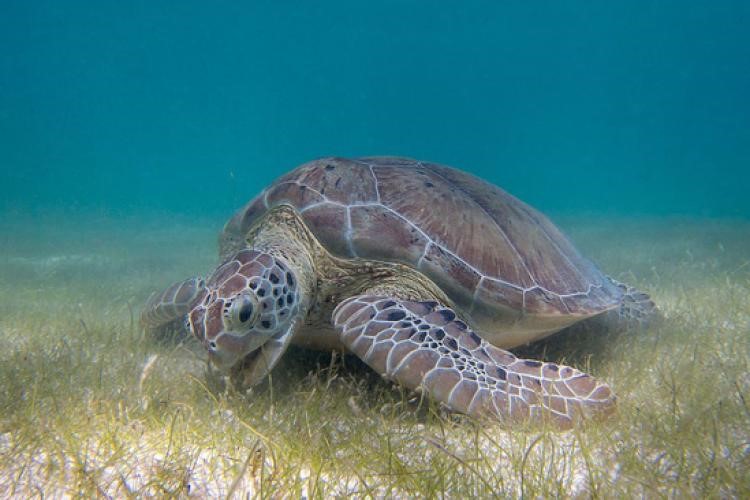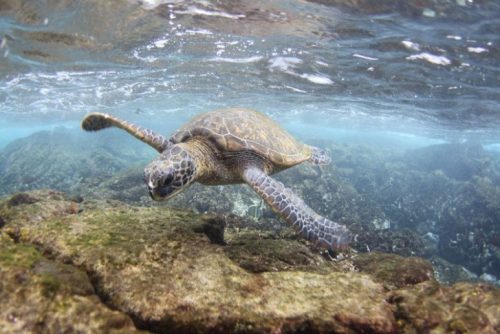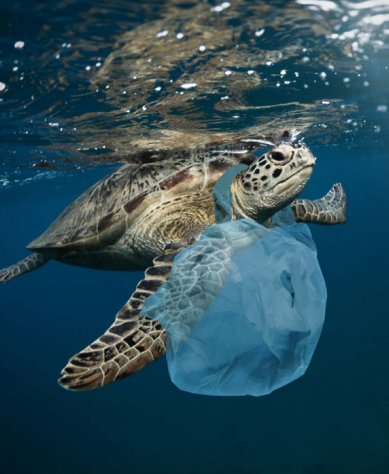Green Turtle Conservation: Global and Local Challenges and Solutions

Photo Credit : NOAA Fisheries
The Green Turtle, a member of the Chordata phylum and Cheloniidae family, stands out as the sole herbivorous turtle species. It primarily feeds on seagrass and marine algae, although it is believed to be omnivorous during its hatchling phase to boost its growth, consuming crabs, jellyfish, and sponges. The name “Green Turtle” is derived not from its shell colour, but from the greenish tint of certain parts of its skin, attributed to a layer of fat beneath its skin.
The Green Turtle is distinguished by its wide carapace, exhibiting a blackish or greenish-yellow colour, with thin white edges. It also possesses a white plastron. This turtle species has an equal number of scales. With a relatively small and blunt head, the Green Turtle’s length varies between 80-150 cm, and it can weigh as much as 132 kg.

Photo Credit : NOAA Fisheries
In Indonesia, the Green Turtle inhabits all Indonesian waters, including the western regions like Aceh, West Sumatra, Riau Islands, and Bangka Belitung, central regions like Pulau Seribu Islands, West Java, Karimun Jawa, West Kalimantan, East Kalimantan, and East Java, and eastern regions like Sulawesi, Bali, East Nusa Tenggara, West Nusa Tenggara, Maluku, and Papua.
Human activity poses a significant threat to the conservation of the Green Turtle. A study by Daniel et al. (2018) revealed that out of 35 turtles that died and washed ashore between 2007 and 2013, 54% had suffered trauma from humans, while 63% had ingested synthetic waste, mainly clear soft plastic. The loss of sand, which serves as a nesting area for turtles to lay their eggs, due to both natural factors and human development activities, presents another threat.

Photo Credit : ACPMEAs
The Green Turtle is a protected species under both national and international laws due to its endangered status, which is a result of natural factors and human activities. Green turtles are classified as endangered, and CITES has included them in Appendix I, along with all other turtle species.
The following are the regulations/legislation related to the protection of turtles and their habitats:
- Law No. 5 of 1990
- Law No. 31 of 2004
- Law No. 45 of 2009
- Government Regulation No. 7 of 1999
- Government Regulation No. 60 of 2007
- Presidential Decree No. 43 of 1978
- Minister of Marine Affairs and Fisheries Circular Letter No. 526 of 2015
Scientific Classification
|
Kingdom: |
Animalia |
|
Phylum: |
Chordata |
|
Class: |
Reptilia |
|
Ordo: |
Testudines |
|
Family: |
Cheloniidae |
|
Genus: |
Chelonia |
|
Species: |
Chelonia mydas (Linnaeus, 1758) |
International Conservation Efforts : Internationally, various organizations and initiatives are working towards the conservation of Green Turtles. These efforts include research and monitoring programs, habitat protection, and public education campaigns. International treaties and agreements, such as CITES, also play a crucial role in protecting Green Turtles from illegal trade.
Conservation Efforts in Indonesia : In Indonesia, the government has enacted several laws and regulations aimed at protecting Green Turtles and their habitats. Conservation efforts in the country include the establishment of protected areas, beach clean-up initiatives, and programs to reduce the impact of human activities on turtle populations.

Photo Credit : Susan M Jackson/Shutterstock
While the Indonesian government and local organizations are making significant strides in conserving the Green Turtle population, there are also several ways individuals can contribute to these efforts and make a difference. Here are some actions you can take to support the conservation of Green Turtles:
- Reduce Plastic Use : As mentioned in the article, many turtles die from consuming plastic waste. By reducing your use of plastic, you can help decrease the amount of plastic waste in the ocean.
- Participate in Conservation Programs : There are many organizations that offer turtle conservation programs. You can participate in these programs, such as mangrove planting, turtle nest guarding, and hatchling release.
- Education : Sharing knowledge about green turtles and the importance of conservation with others can also be very helpful. The more people who know about this issue, the more likely they are to help.
- Support Turtle Protection Policies : Support and comply with regulations and laws that protect turtles and their habitats. This includes not buying products made from turtles or their parts.
- Don’t Disturb Turtles in Their Habitat : If you see turtles in the wild, don’t disturb them. Don’t touch, feed, or take pictures too close to the turtles. This can disturb them and cause them stress.


1 Comment
good article, preserving our ocean ecosystems is crucial, and initiatives like saving turtles play a vital role. Every effort counts in ensuring these incredible creatures thrive🐢